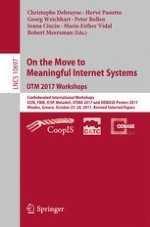2018 | Book | 1. edition
On the Move to Meaningful Internet Systems. OTM 2017 Workshops
Confederated International Workshops, EI2N, FBM, ICSP, Meta4eS, OTMA 2017 and ODBASE Posters 2017, Rhodes, Greece, October 23–28, 2017, Revised Selected Papers
Editors: Christophe Debruyne, Hervé Panetto, Georg Weichhart, Peter Bollen, Ioana Ciuciu, Maria-Esther Vidal, Robert Meersman
Publisher: Springer International Publishing
Book Series : Lecture Notes in Computer Science
